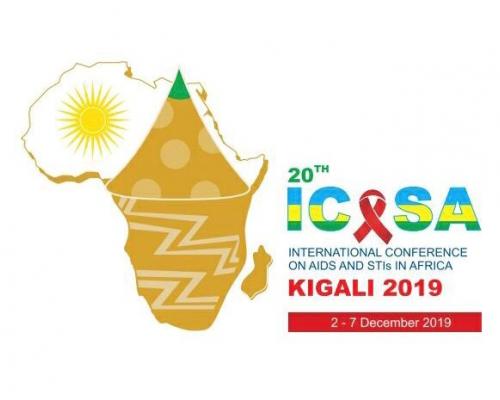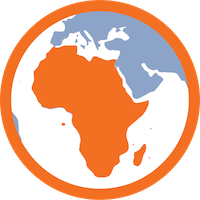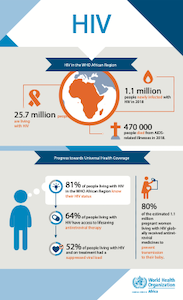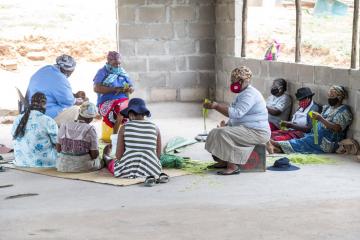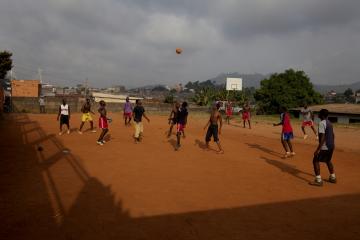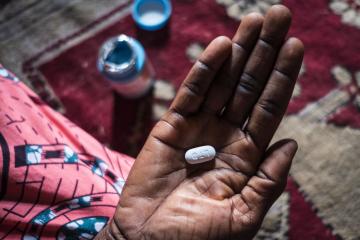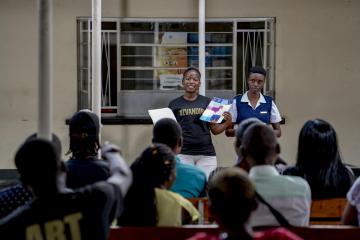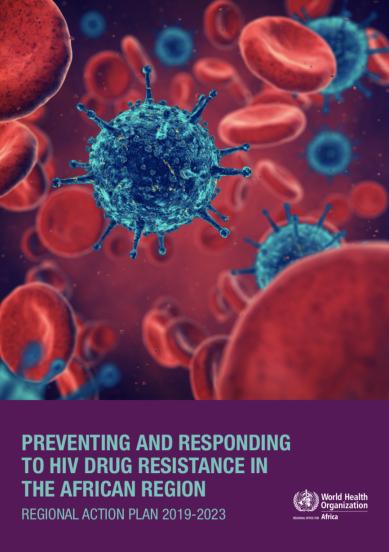Key fact

1.1 million people
newly infected with HIV in 2018.
Featured video
HIV continues to be a major global public health issue, having claimed more than 35 million lives so far. In 2018, some 770 000 people died from HIV-related causes globally.
- There were approximately 37.9 million people living with HIV at the end of 2018 with 1.7 million people becoming newly infected in 2018 globally.
- The WHO African Region is the most affected region, with 25.7 million people living with HIV in 2018. The African Region also accounts for almost two thirds of the global total of new HIV infections. In 2018, about 1.1 million people were infected with HIV in the African Region.
- HIV infection is often diagnosed through rapid diagnostic tests (RDTs), which detect the presence or absence of HIV antibodies. Most often these tests provide same-day test results, which are essential for same-day diagnosis and early treatment and care.
- Key populations and their sexual partners accounted for over half of all new infections (an estimated 54%) for the first time in 2018.
- Key populations include: men who have sex with men, people who inject drugs, people in prisons and other closed settings, sex workers and their clients, and transgender people. They are at increased risk of HIV infection irrespective of epidemic type or local context.
- Key populations, their clients and sexual partners accounted for 64% of new HIV infections in West and Central Africa, and for 25% of new HIV infections in the East and Southern African subregion. Key populations and their partners accounted for around 95% of new HIV infections in eastern Europe and central Asia and in the Middle East and North Africa in 2018.
- Key populations often face legal and social barriers that increase their vulnerability to HIV and impede their access to prevention, testing and treatment programmes.
- There is no cure for HIV infection. However, effective antiretroviral (ARV) drugs can control the virus and help prevent transmission so that people with HIV and those at substantial risk, can enjoy healthy, long and productive lives.
- It is estimated that currently 79% of people with HIV know their status. In 2018, an estimated 23.3 million people living with HIV were receiving antiretroviral therapy (ART) globally.
- Between 2000 and 2018, new HIV infections fell by 37%, and HIV-related deaths fell by 45% with 13.6 million lives saved due to ART in the same period. This achievement was the result of great efforts by national HIV programmes supported by civil society and a range of development partners.
The number of new HIV infections continues to decline. However, the progress is much slower than what is required to reach the targets for 2020. In 2018, there were an estimated 1.1 million new HIV infections in the African Region (770 000 in the East and Southern African subregion; 310 000 in the West and Central African subregion).
In terms of people living with HIV (PLHIV), the WHO African Region is the most affected region, with 25.7 million people living with HIV in 2018. Of that number, 20.3 million PLHIV are found in the East and Southern African subregion, while the West and Central African subregion accounts for 5.4 million PLHIV. Four out of every five people (81%) living with HIV in the Region know their HIV status, which is a very important entry point to accessing HIV treatment services.
The continuing decline in AIDS-related deaths in the African Region is largely driven by the steady scale-up of antiretroviral therapy (ART).
In 2018, a total of 470 000 people died from AIDS-related illnesses in the African Region. This represents a 40% decrease since 2010.
In terms of access to ART:
*16.3 million people in the African Region were accessing treatment in 2018. This corresponds to 64% of the total estimated number of people living with HIV who have access to antiretroviral therapy.
*52% of PLHIV on treatment had a suppressed viral load which keeps the immune system working and prevents illness. In addition, viral suppression helps prevent transmission to others through sex, needle sharing and from mother to child during pregnancy, birth and breastfeeding.
The symptoms of HIV vary depending on the stage of infection. Though people living with HIV tend to be most infectious in the first few months, many are unaware of their status until later stages. In the first few weeks after initial infection, individuals may experience no symptoms or an influenza-like illness including fever, headache, rash, or sore throat.
As the infection progressively weakens the immune system, an individual can develop other signs and symptoms, such as swollen lymph nodes, weight loss, fever, diarrhoea and cough. Without treatment, they could also develop severe illnesses such as tuberculosis, cryptococcal meningitis, severe bacterial infections and cancers such as lymphomas and Kaposi's sarcoma, among others.
Tuberculosis (TB) remains the leading cause of death among people living with HIV, accounting for around one in three AIDS-related deaths.
HIV can be transmitted via the exchange of a variety of body fluids from infected individuals, such as blood, breast milk, semen and vaginal secretions. Individuals cannot become infected through ordinary day-to-day contact such as kissing, hugging, shaking hands, or sharing personal objects, food or water.
Risk factors
There is a greater risk of contracting HIV through:
- having unprotected anal or vaginal sex;
- having another sexually transmitted infection such as syphilis, herpes, chlamydia, gonorrhoea, and bacterial vaginosis;
- sharing contaminated needles, syringes and other injecting equipment and drug solutions when injecting drugs;
- receiving unsafe injections, blood transfusions, tissue transplantation, medical procedures that involve unsterile cutting or piercing; and/or
- sustaining accidental needle stick injuries, including among health workers.
HIV infection can be detected with great accuracy, using WHO prequalified tests within a validated approach. No single HIV test can provide an HIV-positive diagnosis. It is important that these tests be used in combination and in a specific order that has been validated and is based on HIV prevalence of the population being tested.
Serological tests, such as rapid diagnostic tests (RDTs) or enzyme immunoassays (EIAs), detect antibodies produced by an individual as part of their immune system to fight off foreign pathogens, rather than direct detection of HIV itself.
Most individuals develop antibodies to HIV within 28 days of infection and therefore antibodies may not be detectable early, during the so-called “window period”. This early period of infection represents the time of greatest infectivity; however, HIV transmission can occur during all stages of the infection.
It is best practice to also retest all people initially diagnosed as HIV-positive before they enrol in care and/or treatment to rule out any potential testing or reporting error. Notably, once a person diagnosed with HIV has started treatment, they should not be retested.
Testing and diagnosis of HIV-exposed infants has been a challenge because babies carry their biological mothers’ antibodies and it can take months for these to disappear. For infants and children less than 18 months of age, serological testing is not sufficient to identify HIV infection: virologic testing must be provided (at 6 weeks of age, or at birth) to detect the presence of the virus in infants born to mothers living with HIV.
HIV testing should be voluntary – a person has the right to refuse to be tested. Mandatory or coerced testing by a health care provider, authority, or by a partner or family member is not acceptable as it undermines good public health practice and infringes on human rights.
Currently, it is estimated that only 75% of people living with HIV know their HIV status. Countries are looking for ways to rapidly increase uptake of HIV testing services, especially for populations with low access and those at higher risk that would otherwise not get tested. One approach is HIV self-testing, where a person collects his or her own specimen (oral fluid or blood) and then performs an HIV test and interprets the result, often in a private setting, either alone or with someone he or she trusts. In 2016, WHO published the first global guidelines on HIV self-testing. HIV self-testing does not provide a definitive HIV-positive diagnosis: instead, it is an initial test which requires further testing by a health worker.
- Status of HIV silt-testing in national policies (situation as mid-2018)
- A short technical update on self‐testing for HIV
The sexual partners and drug injecting partners of people diagnosed with HIV infection have an increased probability of also being HIV-positive. WHO recommends assisted HIV partner notification services as a simple and effective way of reaching these partners, many of whom are undiagnosed and unaware of their HIV exposure, and may welcome support and an opportunity to test for HIV.
All HIV testing services must follow the 5 Cs principles recommended by WHO:
- Informed Consent
- Confidentiality
- Counselling
- Correct test results
- Connection (linkage to care, treatment and other services).
Individuals can reduce the risk of HIV infection by limiting exposure to risk factors. Key approaches for HIV prevention, which are often used in combination, are listed below.
Male and female condom use
Correct and consistent use of male and female condoms during vaginal or anal penetration can protect against the spread of sexually transmitted infections, including HIV. Evidence shows that male latex condoms have an 85% or greater protective effect against HIV and other sexually transmitted infections (STIs).
For HIV and STIs
Testing for HIV and other STIs is strongly advised for all people exposed to any of the risk factors. Through testing, people learn of their own infection status and access necessary prevention and treatment services without delay. WHO also recommends offering testing for partners or couples. Additionally, WHO is recommending assisted partner notification approaches so that people with HIV receive support to inform their partners either on their own, or with the help of health care providers.
Linkages to tuberculosis care
Tuberculosis (TB) is the most common presenting illness and cause of death among people with HIV. It is fatal if undetected or untreated and is the leading cause of death among people with HIV, responsible for more than one out of three HIV-associated deaths.
Early detection of TB and prompt linkage to TB treatment and ART can prevent these deaths. TB screening should be offered routinely at HIV care services and routine HIV testing should be offered to all patients with presumptive and diagnosed TB. Individuals who are diagnosed with HIV and active TB should urgently start effective TB treatment (including for multidrug-resistant TB) and ART. TB preventive therapy should be offered to all people with HIV who do not have active TB.
This is a key prevention intervention supported in 15 countries in East and Southern Africa (ESA) with high HIV prevalence and low male circumcision rates. VMMC is also regarded as a good approach to reach men and adolescent boys who do not often seek health care services. Since the 2007 WHO recommendation for VMMC as an additional prevention strategy, over 23 million adolescent boys and men in the 15 countries have been circumcised and provided a package of services including HIV testing and education on safer sex and condom use. The 15 countries are; Botswana, Eswatini, Ethiopia, Kenya, Lesotho, Malawi, Mozambique, Namibia, Rwanda, South Africa, South Sudan, United Republic of Tanzania, Uganda, Zambia and Zimbabwe.
Prevention benefits of ART
The WHO recommendation to initiate ART for all people living with HIV will contribute significantly to reducing HIV transmission.
Pre-exposure prophylaxis (PrEP) for HIV-negative partner
Oral PrEP of HIV is the daily use of ARV drugs by HIV-negative people to block HIV infection. More than 10 randomized controlled studies have demonstrated the effectiveness of PrEP in reducing HIV transmission among a range of populations including sero-discordant heterosexual couples (where one partner is infected and the other is not), men who have sex with men, transgender women, high-risk heterosexual couples, and people who inject drugs.
WHO recommends PrEP as a prevention choice for people at substantial risk of HIV infection as part of a combination of prevention approaches. WHO has also expanded these recommendations to HIV-negative women who are pregnant or breastfeeding.
Post-exposure prophylaxis for HIV (PEP)
Post-exposure prophylaxis (PEP) is the use of ARV drugs within 72 hours of exposure to HIV to prevent infection. PEP includes counselling, first-aid care, HIV testing, and administration of a 28-day course of ARV drugs with follow-up care. WHO recommends PEP use for both occupational and non-occupational exposures and for adults and children.
People who inject drugs can take precautions against becoming infected with HIV by using sterile injecting equipment, including needles and syringes, for each injection and not sharing drug-using equipment and drug solutions. Treatment of dependence, and in particular opioid substitution therapy for people dependent on opioids, also helps reduce the risk of HIV transmission and supports adherence to HIV treatment. A comprehensive package of interventions for HIV prevention and treatment includes:
- needle and syringe programmes;
- opioid substitution therapy for people dependent on opioids and other evidence-based drug dependence treatment;
- HIV testing and counselling;
- HIV treatment and care;
- risk-reduction information and education and provision of naloxone;
- access to condoms; and
- management of STIs, tuberculosis and viral hepatitis.
The transmission of HIV from an HIV-positive mother to her child during pregnancy, labour, delivery or breastfeeding is called vertical or mother-to-child transmission (MTCT). In the absence of any interventions during these stages, rates of HIV transmission from mother-to-child can be between 15% and 45%. MTCT can be nearly fully prevented if both the mother and the baby are provided with ARV drugs as early as possible in pregnancy and during the period of breastfeeding.
WHO recommends lifelong ART for all people living with HIV, regardless of their CD4 count or clinical stage of disease, and this includes women who are pregnant or breastfeeding. A growing number of countries are achieving very low rates of MTCT and some (Armenia, Belarus, Cuba and Thailand) have been formally validated for elimination of MTCT of HIV as a public health problem. Several countries with a high burden of HIV infection are also progressing along the path to elimination.
